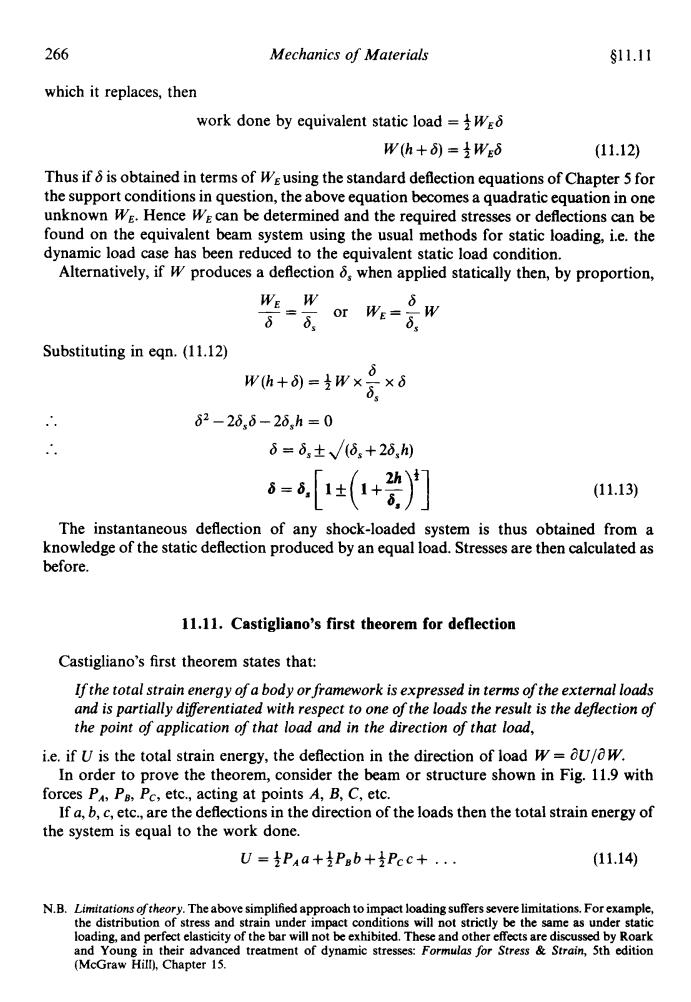正在加载图片...

266 Mechanics of Materials §11.11 which it replaces,then work done by equivalent static load =WEo W(h+)=土WEδ (11.12) Thus if 6 is obtained in terms of We using the standard deflection equations of Chapter 5 for the support conditions in question,the above equation becomes a quadratic equation in one unknown WE.Hence WE can be determined and the required stresses or deflections can be found on the equivalent beam system using the usual methods for static loading,i.e.the dynamic load case has been reduced to the equivalent static load condition. Alternatively,if W produces a deflection 8,when applied statically then,by proportion, WE W 6 6=6 Or WE-5. W Substituting in egn.(11.12) wh+)=含w×司xd 82-26i-2δ,h=0 δ=δ,±√/(6,+2δh) =±(+发] (11.13) The instantaneous deflection of any shock-loaded system is thus obtained from a knowledge of the static deflection produced by an equal load.Stresses are then calculated as before. 11.11.Castigliano's first theorem for deflection Castigliano's first theorem states that: If the total strain energy of a body or framework is expressed in terms of the external loads and is partially differentiated with respect to one of the loads the result is the deflection of the point of application of that load and in the direction of that load, i.e.if U is the total strain energy,the deflection in the direction of load w=ou/ow. In order to prove the theorem,consider the beam or structure shown in Fig.11.9 with forces P,Pa,Pc,etc.,acting at points A,B,C,etc. If a,b,c,etc.,are the deflections in the direction of the loads then the total strain energy of the system is equal to the work done. U=Pa+iP8b+iPcc+... (11.14) N.B.Limitations of theory.The above simplified approach to impact loading suffers severe limitations.For example, the distribution of stress and strain under impact conditions will not strictly be the same as under static loading,and perfect elasticity of the bar will not be exhibited.These and other effects are discussed by Roark and Young in their advanced treatment of dynamic stresses:Formulas for Stress Strain,5th edition (McGraw Hill),Chapter 15.266 Mechanics of Materials $11.11 which it replaces, then work done by equivalent static load = 3 WE6 W(h+6) =$WE6 (11.12) Thus if 6 is obtained in terms of WE using the standard deflection equations of Chapter 5 for the support conditions in question, the above equation becomes a quadratic equation in one unknown WE. Hence WE can be determined and the required stresses or deflections can be found on the equivalent beam system using the usual methods for static loading, Le. the dynamic load case has been reduced to the equivalent static load condition. Alternatively, if W produces a deflection 6, when applied statically then, by proportion, Substituting in eqn. (11.12) 6 W(h+6) =~WX- x6 6, .. 6’ - 26,6 - 26,h = 0 .. 6 = 6, J(6, + 26,h) 6 = 6, [ 1 f (1 +$)’I (11.13) The instantaneous deflection of any shock-loaded system is thus obtained from a knowledge of the static deflection produced by an equal load. Stresses are then calculated as before. 11.11. Castigliano’s first theorem for deflection Castigliano’s first theorem states that: If the total strain energy of a body or framework is expressed in terms of the external loads and is partially dixerentiated with respect to one of the loads the result is the deflection of the point of application of that load and in the direction of that load, i.e. if U is the total strain energy, the deflection in the direction of load W = aU/a W. forces Pa, PB, Pc, etc., acting at points A, B, C, etc. the system is equal to the work done. In order to prove the theorem, consider the beam or structure shown in Fig. 11.9 with If a, b, c, etc., are the deflections in the direction of the loads then the total strain energy of u =+PAa+fPBb+$PcC+ . . . (11.14) N.B. Limitations oftheory. The above simplified approach to impact loading suffers severe limitations. For example, the distribution of stress and strain under impact conditions will not strictly be the same as under static loading, and perfect elasticity of the bar will not be exhibited. These and other effects are discussed by Roark and Young in their advanced treatment of dynamic stresses: Formulas for Stress & Strain, 5th edition (McGraw Hill), Chapter 15